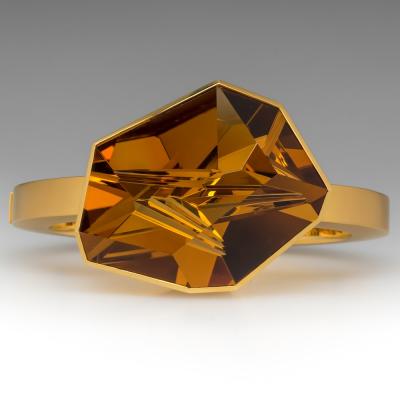
Posted in: Birthstones
 Munsteiner Cut Citrine Bracelet. Photo ©2018 EraGem Jewelry.
In 1912, the American National Association of Jewelers adopted citrine (yellow quartz) as the official birthstone for November. It shares this distinction with November's other birthstone, topaz. While topaz radiates in many different shades, yellow quartz sticks to shades of brown, yellow, and orange.
Munsteiner Cut Citrine Bracelet. Photo ©2018 EraGem Jewelry.
In 1912, the American National Association of Jewelers adopted citrine (yellow quartz) as the official birthstone for November. It shares this distinction with November's other birthstone, topaz. While topaz radiates in many different shades, yellow quartz sticks to shades of brown, yellow, and orange.
A Small Range of Colors
Citrine is a variety of quartz crystal. Quartz comes in many different varieties, including yellow quartz's violet twin amethyst. I call them twins because amethyst transforms into the yellow gemstone when heated. Amethyst is fairly abundant in the earth, whereas natural citrine rarely forms. For it to occur, portions of the quartz minerals must have been subjected to extreme temperatures within the earth. Natural citrine crystallizes in shades of pale yellow to pale orange. Since natural deposits remain scarce, the gemstone industry embraces the use of heat-treated quartz for jewelry. Heat-treated yellow quartz always features a red tint. It appears in shades of dark orange-brown to dark reddish-brown. These mesmerizing shades are surpassed only by medium golden orange and deep sherry.Three Types of Citrine
This beautiful citrusy gemstone comes in three types: aluminum, iron, and heat-treated amethyst. Quartz assumes different colors when traces of other minerals form within the crystal lattice. The presence of aluminum and the subjection to natural heat causes aluminum citrine to form. Aluminum elicits shades of yellow, sometimes with a slightly greenish tint. On occasion, glimpses of smoky quartz appear. Mineralogists struggle to agree on why the presence of aluminum sometimes results in pure smoky quartz and sometimes results in the formation of yellow quartz. The strongest theory for this involves the ratio of aluminum to lithium. The ratio between these to elements also affects the depth of color. Iron-infused yellow quartz primarily result from artificial processes. Scientists grow quartz crystals from a hot silica and water solution. When they add iron to the solution, the resulting specimens form in shades of yellow. Experts estimate that this type of citrine formation sometimes takes place naturally, as well. Finally, heat treatment of amethysts and other quartz specimens results in citrine. Many years ago, the heat treatment of amethysts to form yellow quartz was a common practice. This is why the gemstone industry readily accepts the use of heat-treated citrine in jewelry. This is especially true for antique and vintage jewels. Citrine formed in this fashion is easily identified. For one thing, the tips of the crystal will show a deeper yellow. Also, the coloring may be more concentrated or patchy under the r-rhombohedra. Finally, the absence of dichroism confirms heat treatment. Natural yellow quartz will demonstrate at least a slight amount of dichroism. At EraGem, we offer a variety of shades and types of citrine. Call today to make an appointment to visit our showroom. See which type suits you best!6 years ago
5 view(s) 